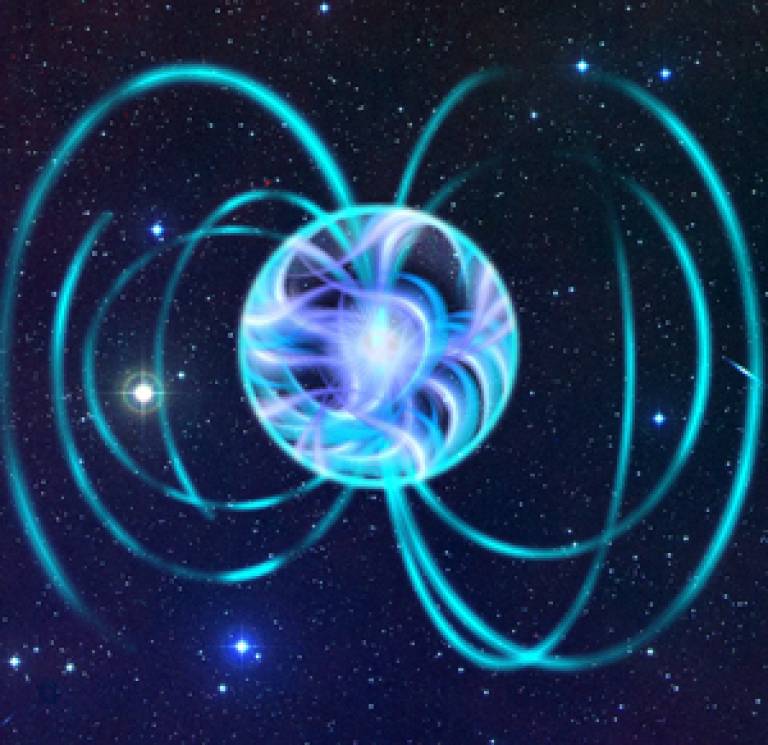Mysterious pulsar with hidden powers discovered
15 October 2010
Links:
 sciencemag.org/cgi/content/abstract/science.1196088" target="_self">Research paper in Science Express
sciencemag.org/cgi/content/abstract/science.1196088" target="_self">Research paper in Science Express
Dramatic
flares and bursts of energy - activity previously thought reserved for only the
strongest magnetized pulsars - have been observed emanating from a weakly
magnetised, slowly rotating pulsar.
The international team of astrophysicists who made the discovery believe that the source of the pulsar's power may be hidden deep within its surface.
Pulsars, or
neutron stars, are the collapsed remains of massive stars. Although they are on
average only about 30km in diameter, they have hugely powerful surface magnetic
fields, billions of times that of our Sun.
The most extreme kind of pulsars have a surface magnetic field 50-1000 times stronger than normal and emit powerful flares of gamma rays and X-rays. Named magnetars (which stands for "magnetic stars") by astronomers, their huge magnetic fields are thought to be the ultimate source of power for the bursts of gamma rays.
Theoretical studies indicate that in magnetars the internal field is actually stronger than the surface field, a property which can deform the crust and spread outwards. The decay of the magnetic field leads to the production of steady and bursting X-ray emissions through the heating of the neutron star crust or the acceleration of particles.
Now, research published today in Science Express, suggests that the same power source can also work for weaker, non-magnetar, pulsars. The observations, which were made by NASA's Chandra and Swift X-ray observatories of the neutron star SGR 0418, may indicate the presence of a huge internal magnetic field in these seemingly less powerful pulsars, which is not matched by their surface magnetic field.
"We have now discovered bursts and flares, i.e. magnetar-like activity, from a new pulsar whose magnetic field is very low," said Dr Silvia Zane, from UCL's (University College London) Mullard Space Science Laboratory, and an author of the research.
Pulsars are highly magnetized, and as they rotate winds of high-energy particles carry energy away from the star, causing the rotation rate of the star to gradually decrease. What sets SGR 0418 apart from similar neutron stars is that, unlike those stars that are observed to be gradually rotating more slowly, careful monitoring of SGR 0418 over a span of 490 days has revealed no evidence that its rotation is decreasing.
"It is the very first time this has been observed and the discovery poses the question of where the powering mechanism is in this case. At this point, we are also interested in how many of the other normal, low field neutron stars that populate the galaxy can at some point wake up and manifest themselves as a flaring source," said Dr Zane, whose research was funded by the Science and Technology Facilities Council.
A crucial question is how large an imbalance can be maintained between the surface and interior magnetic fields. SGR 0418 represents an important test case.
"If further observations by Chandra and other satellites push the surface magnetic field limit lower, then theorists may have to dig deeper for an explanation of this enigmatic object," said Dr Nanda Rea, Institut de Ciencies de l'Espai (ICE-CSIC, IEEC) in Barcelona, who led the discovery.
Image: An artistic impression of a magnetar with a very complicated magnetic field at its interior and a simple small dipolar field outside Credit: ESA, Christophe Carreau
Media contact: Clare Ryan
UCL context
The Mullard Space Science Laboratory is the UK's largest university-based space science research group
and delivers a cutting-edge science programme, underpinned by a
capability in space science instrumentation, systems engineering and
project management.
Related news
Watch: Studying the Sun
Minister David Willetts gives keynote at UCL on space science
 Close
Close

